2016 Moto Guzzi V7 II Stone Review
New, authentic Italian retro
Moto Guzzi is a brand unlike any other. Now in its 95th year of uninterrupted production, Guzzi remains entirely authentic in its retro appeal. Some other manufacturers resort to conjuring up a pseudo historical style and attempt to breed in some characteristics of yesteryear.
2016 Moto Guzzi V7 II Stone
| Engine | 16.0/20 |
| Suspension/Handling | 10.5/15 |
| Transmission/Clutch | 6.5/10 |
| Brakes | 7.25/10 |
| Instruments/Controls | 3.75/5 |
| Ergonomics/Comfort | 7.75/10 |
| Appearance/Quality | 9.0/10 |
| Desirability | 8.0/10 |
| Value | 7.5/10 |
| Overall Score | 76.25/100 |
But Moto Guzzi does not. And not Harley-Davidson, either, which has truckloads of its own history. And this brings me to a not entirely original analogy: Moto Guzzi is the Italian version of Harley. Long heritage of charming air-cooled V-Twins with pushrods: check. Fervent devotion to a historic brand: check. Ardent respect for nationalist design: check. Huge success all over the globe: Well, let’s just say the Italian eagle doesn’t soar as high as the American one in terms of sales.
2016 Moto Guzzi V9 Bobber And V9 Roamer First Ride Review
But having the opportunity to ride the latest update to the V7 platform reinforced our impressions of this uniquely appealing machine. It’s still the only 90-degree V-Twin mounted with its crankshaft inline with its wheels, and it retains its shaft-drive arrangement that is fairly unusual for bikes not in the touring or cruiser realms.
The V7 II massages the V7 platform, with the biggest changes being the rotation of the engine 4 degrees forward in the chassis and the addition of a sixth gear to the transmission. Traction control is now standard equipment, as is an ABS system from Continental.
The reoriented engine – now tuned to be able to meet stringent Euro 4 standards – yields more than an inch of extra space for knees and shins, plus the footpegs are an inch lower, which comes in handy considering the seat height has been shaved by 15mm to 31.1 inches. The cardan shaft output was lowered by 2 inches, and Guzzi says decreasing the angle of pull “enhances the effect of the rear suspension ensuring a better grip on the ground,” a claim impossible to verify from the saddle.
The drivetrain modifications include a new clutch lever and inner clutch components intended to deliver a “softer action and a more even release,” according to Guzzi, and its primary-drive gearing is shorter, going from 16.2 to 18.2:1. A steeper first gear allows easier getaways, while the addition of a sixth gear enabled closer spacing between gears 3, 4 and 5, plus the promise of lower fuel consumption at highway speeds. Transmission oil changes have been radically extended from 6,000 miles to 30,000 miles.
As usual, the Guzzi’s V-Twin plays a key role in the riding experience, with its pair of cylinders jutting out from both sides of the fuel tank and the whole bike rocking to the right when its throttle is blipped. The 90-degree vee architecture (like Ducatis) ensures a smooth engine that sounds wonderful to gearheads. A rev limiter halts the party at a relatively low 7200 rpm, but it wasn’t unusual for me to find myself cruising all the way up at 5000 rpm because the mill is so creamy other than intermittent tingles through the pegs and bars.
The engine feels a bit more eager than previous thanks to the gearing changes, and the V7 II proves to be easier to get off the line. This is a great benefit considering the single-plate dry clutch has a rather narrow engagement point and can get overwhelmed during high-rpm slipping; keeping the heavy flywheel’s revs low and feeling the clutch bite before adding throttle is the V7’s preferred launch method. Gearshifts are very smooth if unhurrried, and the new top gear keeps highway cruising fairly serene.
The peak horsepower number when measured at the rear wheel, 41.8 hp, is almost comically low for a 744cc motor, but the lovely little mill always feels and sounds more powerful than it actually is. Ample grunt is always on tap throughout the rev range despite the modest peak numbers, including 40 lb-ft of torque at just 3000 rpm, and it’s seldom when a rider is asking for more.
The V7 II’s riding position is about perfect for this style of bike, with a moderately sporty forward lean to the bars without placing any pressure on wrists. Legroom is quite sufficient, and the footpegs slightly rear-set are reasonably comfortable. The flat design of the rider’s seat harkens back to earlier times and reminds us that it’s better than being stuck in a confining pocket, even if the modest padding here has a rider squirming after an hour or so. The V7 is remarkably slim between the knees considering its large, 5.8-gallon capacity; that’s an easy 250 miles or more between fuel stops.
The Stone handles better than its name implies, steering deliberately like a traditional Italian bike from the 1970s rather than a modern scalpel. Scaling in at 454 lbs full of about 35 lbs of fuel, the V7 is quite light, especially considering its shaft-drive layout is significantly heavier than a chain. Brakes are by Brembo, but they’re lacking power and feel compared to what we’ve become spoiled by from the famous Italian brake brand.
HepCat TooCool Millennial Shootout
Classy dual gauges with chrome bezels look authentically retro while having modern displays for time and ambient temperature. Traction control, which has a fairly low level before intervention, can be switched off by holding down the starter button.
“While certainly capable of getting up and going in a relative hurry,” Evans Brasfield comments, “the V7’s stateliness carries through in its deliberate handling and engine character. The new V7 II is a modernized version of a classic design, and for better or worse, it won’t let you forget it.”
2016 Moto Guzzi V7 II Stone
+ Highs
- Authentic Italian appeal
- Improved ergonomics
- A classic with a warranty!
– Sighs
- A few ponies short of a full corral
- Retro clutch
- Retro handling
The V7 II Stone reminds us that motorcycles needn’t have 150 horsepower and electronic suspension to entertain street and urban riders. It’s an elemental motorbike that is versatile and able to handle most any street task asked by both grizzled veterans and skinny-jeans-wearing youngsters.
Priced at $8,990, including a two-year warranty, it’s the cheapest streetbike built in Italy. In fact, it might even be the cheapest motorcycle built in Europe — Ducati’s popular Scrambler and Triumph’s new Bonneville lineup are produced in Thailand. The V7 is built at the same historic Guzzi factory in Mandello del Lario as the first ones back in 1921. Even the best PR firms can’t manufacture authenticity that real.
2016 Moto Guzzi V7 II Stone | |
|---|---|
| MSRP as tested | $8,990.00 |
| Engine Capacity | 744 cc |
| Engine Type | 90° V-Twin, air-cooled |
| Bore x Stroke | 80.0 x 74.0 mm |
| Compression Ratio | NA |
| Fuel System | Weber-Marelli electronic fuel injection |
| Transmission | 6-speed |
| Final Drive | Shaft |
| Front Suspension | 40mm telescopic fork, 5.1 in. travel |
| Rear Suspension | Die cast light alloy swing arm with 2 shock absorbers with adjustable spring preload,4.4 in.travel |
| Front Brakes | 320 mm stainless steel floating discs, Brembo callipers with 4 differently sized opposed pistons,ABS |
| Rear Brakes | 260 mm, stainless steel disc, floating calliper with 2 pistons,ABS |
| Front Tire | 100/90-18 |
| Rear Tire | 130/80-17 |
| Seat Height | 31.1 in. |
| Wheelbase | 57.0 in. |
| Rake/Trail | 27°50ʼ/4.6 in. |
| Measured Weight | 454 lbs. |
| Fuel Capacity | 5.8 gal. |
More by Kevin Duke




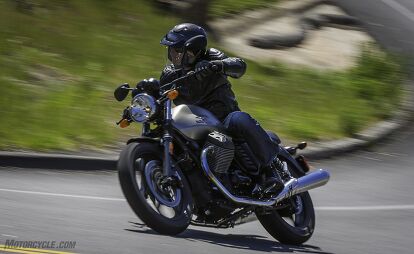




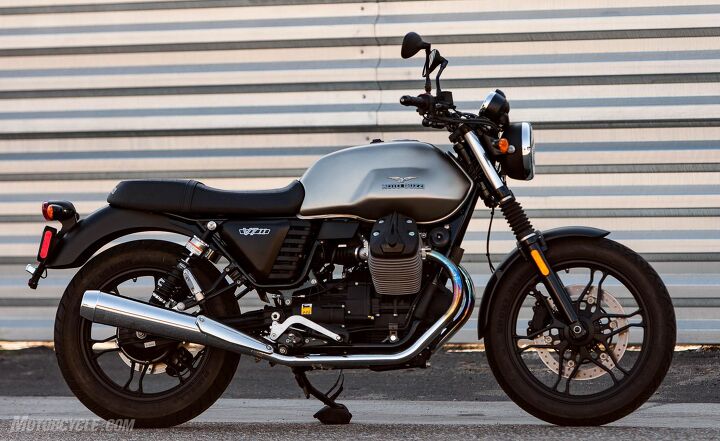















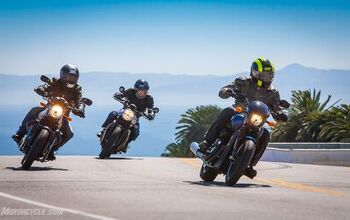
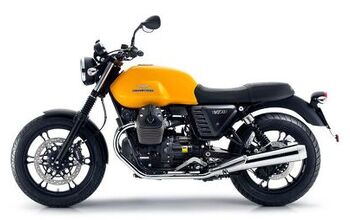
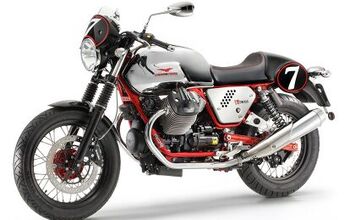

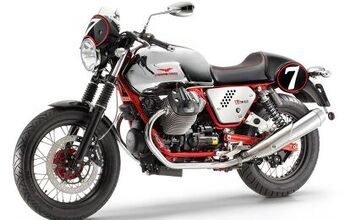












Comments
Join the conversation
Loved my 2012 V7 (H-B hard bags, luggage rack, Ikon shocks, Breva 750 flyscreen) when it was running . Unfortunately it spent more time in the shop than on the road (more than 6 months in the shop in 2 years and 20,000km. intermitent starting problems then the clutch). And absolutely no support from Piaggio NA or my local dealer.
I fear the 950 will take the block and especially the clutch beyond its limits (my V7 ate it's clutch with less than 20,000km on it. seized actuator piston) All my other guzzi's (2 850T's, V50 Monza, 1000SP, which i still have with 170,000km, V65SP, 750 Breva, California Special Sport) were more reliable.
And that's damning with faint praise because truth be told, only the Monza was problem free (of course it only had 12,000km on it when i traded it for the V65)
The T's had electrical problems and scored bores, the SP had leaky seals and electrical issues, the V65 had seized valves, the Breva had electrical problems and the Cal lost its fuel injection on the left side and the odometer and the fuel warning light went south at the same time (leaving me with the dipstick fuel gauge method).
I've done over 250,000 miles on 8 guzzis and i could have done the same on one Goldwing with fewer problems (but it would still be a goldwing)
Guzzis. Love em, but can no longer live with them.
Beautiful machine, well done MG. A Special, in blue please.